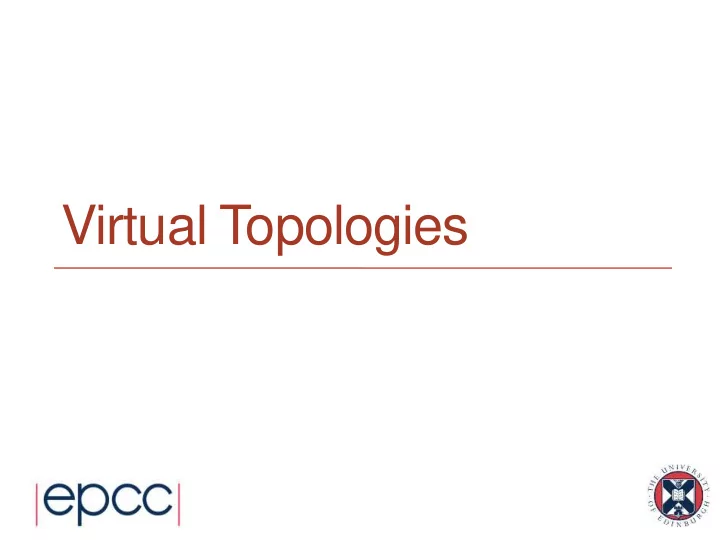

Virtual Topologies
Virtual Topologies • Convenient process naming. • Naming scheme to fit the communication pattern. • Simplifies writing of code. • Can allow MPI to optimise communications. 2
How to use a Virtual Topology • Creating a topology produces a new communicator. • MPI provides “mapping functions”. • Mapping functions compute processor ranks, based on the topology naming scheme. 3
Example A 2-dimensional Cylinder 0 1 2 3 (0,0) (0,1) (0,2) (0,3) 4 5 6 7 (1,0) (1,1) (1,2) (1,3) 8 9 10 11 (2,0) (2,1) (2,2) (2,3) 4
Topology types • Cartesian topologies - each process is “connected” to its neighbours in a virtual grid. • boundaries can be cyclic, or not. • optionally re-order ranks to allow MPI implementation to optimise for underlying network interconnectivity. - processes are identified by cartesian coordinates. • Graph topologies - general graphs - not covered here 5
Creating a Cartesian Virtual Topology • C: int MPI_Cart_create(MPI_Comm comm_old, int ndims, int *dims, int *periods, int reorder, MPI_Comm *comm_cart) • Fortran: MPI_CART_CREATE(COMM_OLD, NDIMS, DIMS, PERIODS, REORDER, COMM_CART, IERROR) INTEGER COMM_OLD, NDIMS, DIMS(*), COMM_CART, IERROR LOGICAL PERIODS(*), REORDER 6
Balanced Processor Distribution • C: int MPI_Dims_create( int nnodes, int ndims, int *dims ) • Fortran: MPI_DIMS_CREATE(NNODES, NDIMS, DIMS, IERROR) INTEGER NNODES, NDIMS, DIMS(*), IERROR 7
MPI_Dims_create • Call tries to set dimensions as close to each other as possible dims before call function call dims on return MPI_DIMS_CREATE( 6, 2, dims) (0, 0) (3, 2) MPI_DIMS_CREATE( 7, 2, dims) (0, 0) (7, 1) MPI_DIMS_CREATE( 6, 3, dims) (0, 3, 0) (2, 3, 1) MPI_DIMS_CREATE( 7, 3, dims) (0, 3, 0) erroneous call • Non zero values in dims sets the number of processors required in that direction - WARNING: make sure dims is set to zero before the call 8
Cartesian Mapping Functions Mapping process grid coordinates to ranks • C: int MPI_Cart_rank( MPI_Comm comm, int *coords, int *rank) • Fortran: MPI_CART_RANK (COMM, COORDS, RANK, IERROR) INTEGER COMM, COORDS(*), RANK, IERROR 9
Cartesian Mapping Functions Mapping ranks to process grid coordinates • C: int MPI_Cart_coords(MPI_Comm comm, int rank, int maxdims, int *coords) • Fortran: MPI_CART_COORDS(COMM, RANK, MAXDIMS, COORDS,IERROR) INTEGER COMM, RANK, MAXDIMS, COORDS(*), IERROR 10
Cartesian Mapping Functions Computing ranks of my neighbouring processes Following conventions of MPI_SendRecv • C: int MPI_Cart_shift(MPI_Comm comm, int direction, int disp, int *rank_source, int *rank_dest ) • Fortran: MPI_CART_SHIFT(COMM, DIRECTION, DISP, RANK_SOURCE, RANK_DEST, IERROR) INTEGER COMM, DIRECTION, DISP, RANK_SOURCE, RANK_DEST, IERROR 11
Non-existent ranks • What if you ask for the rank of a non-existent process? - or look off the edge of a non-periodic grid? • MPI returns a NULL processor - rank is MPI_PROC_NULL • MPI_PROC_NULL is a black hole - sends and receives complete immediately - send buffer disappears, receive buffer isn ’ t touched - like UNIX /dev/null 12
Cartesian Partitioning • Cut a grid up into “slices”. • A new communicator is produced for each slice. • Each slice can then perform its own collective communications. • MPI_Cart_sub and MPI_CART_SUB generate new communicators for the slices. - Use array to specify which dimensions should be retained in the new communicator. 13
Partitioning with MPI_CART_SUB • C: int MPI_Cart_sub ( MPI_Comm comm, int *remain_dims, MPI_Comm *newcomm) • Fortran: MPI_CART_SUB (COMM, REMAIN_DIMS, NEWCOMM,IERROR) INTEGER COMM, NEWCOMM, IERROR LOGICAL REMAIN_DIMS(*) 14
Exercise • See Exercise 6 on the sheet • Rewrite the exercise passing numbers round the ring using a one-dimensional ring topology. 15
Recommend
More recommend